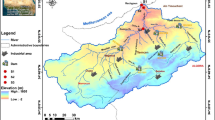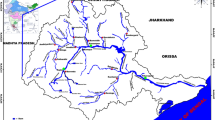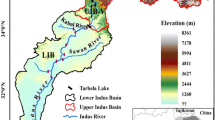Abstract
Thorough knowledge of hydrochemical characteristics and trace element concentrations in surface waters is crucial for protection of this resource, especially in arid regions. Uzbekistan lies in central, arid Central Asia, and is experiencing severe water scarcity as a consequence of warming climate and accelerated human impacts. Fifty-five surface water samples were collected from the Amu Darya Basin of Uzbekistan (ADBU) and measured for relevant variables, to determine hydrochemical characteristics and evaluate water quality. River water samples from the middle reach and Amu Darya Delta (ADD) were dominantly HCO3–Ca and SO4–Ca·Mg types, respectively, whereas water samples collected near the former shoreline and sewage outlets in the ADD were predominantly Cl–Ca·Mg and Cl–Na types, consistent with the distribution of sites that display high concentrations of trace elements and are seriously affected by human activities. Principal component analysis indicated that Pb and Cd in surface waters of the ADBU had industrial origins. Local agricultural activities are thought to have contributed to the concentrations of NO3, Zn, Ni, Hg, and Mn, through pesticide and fertilizer applications, and concentrations of Cu, Cr, As, and Co are controlled by mixed natural and anthropogenic sources. Water quality and health risk assessments indicated that unsuitable drinking waters are distributed mainly near the former shoreline and sewage outlets in the ADD, making human health risks in these areas high.








Similar content being viewed by others
References
Awan UK, Tischbein B, Martius C (2015) Simulating groundwater dynamics using FEFLOW-3D groundwater model under complex irrigation and drainage network of dryland ecosystems of Central Asia. Irrig. Drain. 64:283–296. https://doi.org/10.1002/ird.1897
Chadha DK (1999) A proposed new diagram for geochemical classification of natural waters and interpretation of chemical data. Hydrogeol J 7:431–439. https://doi.org/10.1007/s100400050216
Chanpiwat P, Sthiannopkao S (2014) Status of metal levels and their potential sources of contamination in Southeast Asian rivers. Environ Sci Pollut R 21:220–233. https://doi.org/10.1007/s11356-013-1858-8
Crosa G, Stefani F, Bianchi C, Fumagalli A (2006) Water security in Uzbekistan: implication of return waters on the Amu Darya water quality. Environ Sci Pollut R 13:37–42. https://doi.org/10.1065/espr2006.01.007
Dubovyk O, Menz G, Conrad C, Kan E, Machwitz M, Khamzina A (2013) Spatio-temporal analyses of cropland degradation in the irrigated lowlands of Uzbekistan using remote-sensing and logistic regression modeling. Environ Monit Assess 185:4775–4790. https://doi.org/10.1007/s10661-012-2904-6
Egamberdiyeva D, Mamiev M, Poberejskaya SK (2001) The influence of mineral fertilizer combined with a nitrification inhibitor on microbial populations and activities in calcareous Uzbekistanian soil under cotton cultivation. Sci World J 1(S2):108–113. https://doi.org/10.1100/tsw.2001.301
Gaillardet J, Dupre B, Louvat P, Allegre CJ (1999) Global silicate weathering and CO2 consumption rates deduced from the chemistry of large rivers. Chem Geol 159:3–30. https://doi.org/10.1016/S0009-2541(99)00031-5
Gaillardet J, Viers J, Dupré B (2005) Trace elements in river waters. Surface and Ground Water, Weathering, and Soils 5:225–272. https://doi.org/10.1016/B0-08-043751-6/05165-3
Gibbs RJ (1970) Mechanisms controlling world water chemistry. Science 170:1088–1090. https://doi.org/10.1126/science.170.3962.1088
Glantz M (1999) Creeping environmental problems and sustainable development in the Aral Sea Basin. Cambridge University Press. https://doi.org/10.1017/CBO9780511535970
Graham NT, Hejazi MI, Kim SH, Davies EGR, Edmonds JA, Miralles-Wilhelm F (2020) Future changes in the trading of virtual water. Nat Commun 11:3632. https://doi.org/10.1038/s41467-020-17400-4
Habib MA, Islam AMT, Bodrud-Doza M, Mukta FA, Khan R, Siddique MA, Phoungthong K, Techato K (2020) Simultaneous appraisals of pathway and probable health risk associated with trace metals contamination in groundwater from Barapukuria coal basin, Bangladesh. Chemosphere 242:125183. https://doi.org/10.1016/j.chemosphere.2019.125183
Han GL, Liu CQ (2004) Water geochemistry controlled by carbonate dissolution: a study of the river waters draining karst-dominated terrain, Guizhou Province, China. Chem Geol 204:1–21. https://doi.org/10.1016/j.chemgeo.2003.09.009
Islam AMT, Islam HMT, Mia MU, Khan R, Habib MA, Bodrud-Doza M, Siddique MA, Chu RH (2020) Co-distribution, possible origins, status and potential health risk of trace elements in surface water sources from six major river basins, Bangladesh. Chemosphere 249:126180. https://doi.org/10.1016/j.chemosphere.2020.126180
Jalilov SM, Amer SA, Ward FA (2018) Managing the water-energy-food nexus: Opportunities in Central Asia. J Hydrol 557:407–425. https://doi.org/10.1016/j.jhydrol.2017.12.040
Khanday SA, Bhat SU, Islam ST, Sabha I (2021) Identifying lithogenic and anthropogenic factors responsible for spatio-seasonal patterns and quality evaluation of snow melt waters of the River Jhelum Basin in Kashmir Himalaya. Catena 196:104853. https://doi.org/10.1016/j.catena.2020.104853
Kundzewicz ZW, Kowalczak P (2009) The potential for water conflict is on the increase. Nature 459:31–31. https://doi.org/10.1038/459031a
Li PY, He S, Yang NN, Xiang G (2018) Groundwater quality assessment for domestic and agricultural purposes in Yan’an City, northwest China: implications to sustainable groundwater quality management on the Loess Plateau. Environ Earth Sci 77:775. https://doi.org/10.1007/s12665-018-7968-3
Micklin P (2007) The Aral Sea disaster. Annu Rev Earth Planet Sci 35: 47–72. https://doi.org/10.1146/annurev.earth.35.031306.140120
Mirshadiev M, Fleskens L, van Dam J, Pulatov A (2018) Scoping of promising land management and water use practices in the dry areas of Uzbekistan. Agric Water Manag 207:15–25. https://doi.org/10.1016/j.agwat.2018.05.015
Njuguna SM, Onyango JA, Githaiga KB, Gituru RW, Yan X (2020) Application of multivariate statistical analysis and water quality index in health risk assessment by domestic use of river water. Case study of Tana River in Kenya. Process Saf Environ Prot 133:149–158. https://doi.org/10.1016/j.psep.2019.11.006
Papa E, Castiglioni S, Gramatica P, Nikolayenko V, Kayumov O, Calamari D (2004) Screening the leaching tendency of pesticides applied in the Amu Darya Basin (Uzbekistan). Water Res 38:3485–3494. https://doi.org/10.1016/j.watres.2004.04.053
Raj D, Shaji E (2017) Fluoride contamination in groundwater resources of Alleppey, southern India. Geosci Front 8:117–124. https://doi.org/10.1016/j.gsf.2016.01.002
Ren X, Li P, He X, Su F, Elumalai V (2021) Hydrogeochemical processes affecting groundwater chemistry in the Central Part of the Guanzhong Basin, China. Arch Environ Contam Toxicol 80:74–91. https://doi.org/10.1007/s00244-020-00772-5
Rezaei A, Hassani H, Hassani S, Jabbari N, Fard Mousavi SB, Rezaei S (2019) Evaluation of groundwater quality and heavy metal pollution indices in Bazman Basin, Southeastern Iran. Groundw. Sustain. Dev. 9:100245. https://doi.org/10.1016/j.gsd.2019.100245
Rezaei A, Hassani H, Tziritis E, Fard Mousavi SB, Jabbari N (2020) Hydrochemical characterization and evaluation of groundwater quality in Dalgan basin, SE Iran. Groundw. Sustain Dev 10:100353. https://doi.org/10.1016/j.gsd.2020.100353
Schettler G, Oberhänsli H, Stulina G, Mavlonov AA, Naumann R (2013) Hydrochemical water evolution in the Aral Sea Basin. Part I: unconfined groundwater of the Amu Darya Delta-Interactions with surface waters. J. Hydrol. 495:267–284. https://doi.org/10.1016/j.jhydrol.2013.03.044
Schiermeier Q (2001) Ecologists plot to turn the tide for shrinking lake. Nature 412:756–756. https://doi.org/10.1038/35090704
Shibuo Y, Jarsjo J, Destouni G (2006) Bathymetry-topography effects on saltwater-fresh groundwater interactions around the shrinking Aral Sea. Water Resour Res 42:W11410. https://doi.org/10.1029/2005WR004207
Tornqvist R, Jarsjo J, Karimov B (2011) Health risks from large-scale water pollution: trends in Central Asia. Environ Int. 37:435–442. https://doi.org/10.1016/j.envint.2010.11.006
UENP (2016) Third National Communication of the republic of Uzbekistan under the UN Framework Convention on Climate Change. Available from: https://unfccc.int/sites/default/files/resource/TNC%20of%20Uzbekistan%20under%20UNFCCC_english_n.pdf. Accessed 9 Aug 2021
USEPA (2004) Risk Assessment Guidance for Superfund Volume 1. Human Health Evaluation Manual (Part E, Supplemental Guidance for Dermal Risk Assessment). Available from: https://www.epa.gov/sites/default/files/2015-09/documents/part_e_final_revision_10-03-07.pdf. Accessed 9 Aug 2021
USEPA (2010) Regional Screening Level (RSL) tapwater supporting table. Available from: https://epa-prgs.ornl.gov/chemicals/download/master_sl_table_run_JUN2011.pdf. Accessed 9 Aug 2021
Vitola I, Vircavs V, Abramenko K, Lauva D, Veinbergs A (2012) Precipitation and air temperature impact on seasonal variations of groundwater levels. Environ Clim Technol 10:25–33. https://doi.org/10.2478/v10145-012-0022-x
Wang XL, Luo Y, Sun L, He CS, Zhang YQ, Liu SY (2016) Attribution of runoff decline in the Amu Darya River in Central Asia during 1951-2007. J Hydrometeorol 17:1543–1560. https://doi.org/10.1175/JHM-D-15-0114.1
Wang J, Liu GJ, Liu HQ, Lam PKS (2017) Multivariate statistical evaluation of dissolved trace elements and a water quality assessment in the middle reaches of Huaihe River, Anhui, China. Sci Total Environ 583:421–431. https://doi.org/10.1016/j.scitotenv.2017.01.088
Wei MJ, Wu JH, Li WQ, Zhang QX, Su FM, Wang YH (2021) Groundwater geochemistry and its impacts on groundwater arsenic enrichment, variation, and health risks in Yongning County, Yinchuan Plain of northwest China. Expos. Health 1–20. https://doi.org/10.1007/s12403-021-00391-y
WHO (World Health Organization) (2011) Guidelines for drinking water quality, fourth ed. Available from: http://apps.who.int/iris/bitstream/handle/10665/44584/9789241548151_eng.pdf;sequence=1. Accessed 9 Aug 2021
Wu HW, Wu JL, Li J, Fu CS (2020) Spatial variations of hydrochemistry and stable isotopes in mountainous river water from the Central Asian headwaters of the Tajikistan Pamirs. Catena 193:104639. https://doi.org/10.1016/j.catena.2020.104639
Yang XW, Wang NL, Chen AA, He J, Hua T, Qie YF (2020) Changes in area and water volume of the Aral Sea in the arid Central Asia over the period of 1960-2018 and their causes. Catena 191:104566. https://doi.org/10.1016/j.catena.2020.104566
Zeng XX, Liu YG, You SH, Zeng GM, Tan XF, Hu XJ, Hu X, Huang L, Li F (2015) Spatial distribution, health risk assessment and statistical source identification of the trace elements in surface water from the Xiangjiang River, China. Environ Sci Pollut R 22:9400–9412. https://doi.org/10.1007/s11356-014-4064-4
Zhan SE, Wu JL, Wang JZ, Jing M (2020) Distribution characteristics, sources identification and risk assessment of n-alkanes and heavy metals in surface sediments, Tajikistan, Central Asia. Sci Total Environ 709:136278. https://doi.org/10.1016/j.scitotenv.2019.136278
Acknowledgements
We thank the CAS Research Center for Ecology and Environment of Central Asia for assistance with this work, and Huawu Wu and Beibei Shen for field and laboratory assistance. We also thank Mark Brenner for editorial help and three anonymous reviewers for their helpful comments.
Availability of data and materials
The data sets supporting the results of this article are included within the article.
Funding
The study was supported by the National Natural Science Foundation of China (41671200, and U2003202), and the Strategic Priority Research Program of Chinese Academy of Sciences, Pan-Third Pole Environment Study for a Green Silk Road (XDA2006030101).
Author information
Authors and Affiliations
Contributions
Shuie Zhan: conceptualization, software, data curation, writing—original draft.
Jinglu Wu: funding acquisition; investigation; writing—review and editing; validation.
Miao Jin: investigation.
Corresponding author
Ethics declarations
Ethical approval and consent to participate
Not applicable
Consent to publish
Not applicable
Competing interests
The authors declare no competing interests.
Additional information
Responsible Editor: Xianliang Yi
Publisher’s note
Springer Nature remains neutral with regard to jurisdictional claims in published maps and institutional affiliations.
Supplementary Information
ESM 1
(DOC 4025 kb)
Rights and permissions
About this article
Cite this article
Zhan, S., Wu, J. & Jin, M. Hydrochemical characteristics, trace element sources, and health risk assessment of surface waters in the Amu Darya Basin of Uzbekistan, arid Central Asia. Environ Sci Pollut Res 29, 5269–5281 (2022). https://doi.org/10.1007/s11356-021-15799-x
Received:
Accepted:
Published:
Issue Date:
DOI: https://doi.org/10.1007/s11356-021-15799-x




